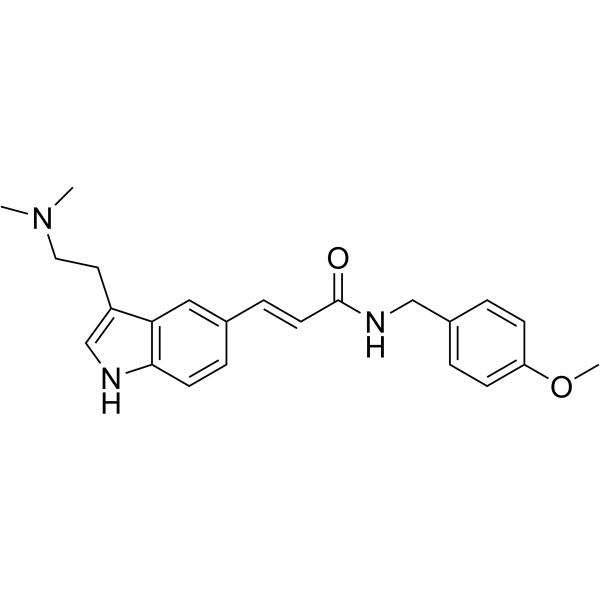GR 46611
Modify Date: 2024-04-05 15:21:25

GR 46611 structure
|
Common Name | GR 46611 | ||
|---|---|---|---|---|
| CAS Number | 185259-85-2 | Molecular Weight | 377.47900 | |
| Density | 1.168g/cm3 | Boiling Point | 645.9ºC at 760mmHg | |
| Molecular Formula | C23H27N3O2 | Melting Point | N/A | |
| MSDS | N/A | Flash Point | 344.4ºC | |
Use of GR 46611GR-46611 is a 5-HT1D receptor agonist. GR-46611 can be used in the research of bladder hyperactivity, leukemia[1][3]. |
| Name | (E)-3-[3-[2-(dimethylamino)ethyl]-1H-indol-5-yl]-N-[(4-methoxyphenyl)methyl]prop-2-enamide |
|---|---|
| Synonym | More Synonyms |
| Description | GR-46611 is a 5-HT1D receptor agonist. GR-46611 can be used in the research of bladder hyperactivity, leukemia[1][3]. |
|---|---|
| Related Catalog | |
| Target |
5-HT1D Receptor |
| In Vitro | GR-46611 (1 μM, 48 h) induces CEM cell proliferation[2]. Cell Proliferation Assay[2] Cell Line: CEM cells (human T lymphoblastic leukemia cell line) Concentration: 1 μM Incubation Time: 48 h Result: Induced a significant increase in cell proliferation by 37.0%. |
| In Vivo | GR-46611 (1 mg/kg, i.p. ) significantly improves survival of Dravet syndrome (DS) mice[1]. GR-46611 (0.03-300 μg/kg, i.v.) increases threshold volume, bladder capacity, and residual volume in chronic spinal cord injury (SCI) cats[3]. GR46611 (3-30 mg/kg, s.c.) causes a dose-related decrease in rectal temperature in the adult guinea-pig[4]. Animal Model: Dravet syndrome (DS) mice[1] Dosage: 0.01, 0.1 and 1 mg/kg Administration: Intraperitoneal injection (i.p.) Result: Improved survival relative to vehicle treated controls with 89% surviving rate. |
| References |
| Density | 1.168g/cm3 |
|---|---|
| Boiling Point | 645.9ºC at 760mmHg |
| Molecular Formula | C23H27N3O2 |
| Molecular Weight | 377.47900 |
| Flash Point | 344.4ºC |
| Exact Mass | 377.21000 |
| PSA | 57.36000 |
| LogP | 4.00110 |
| Vapour Pressure | 1.43E-16mmHg at 25°C |
| Index of Refraction | 1.639 |
| Storage condition | -20°C |
| Hazard Codes | Xi: Irritant; |
|---|---|
| Risk Phrases | R36/37/38 |
| Safety Phrases | S26 |
| GR 4661 |
| Mecamylamine hydrochloride |